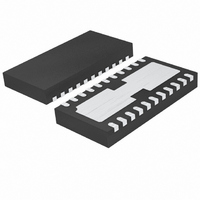LTC4089EDJC-5#PBF Linear Technology, LTC4089EDJC-5#PBF Datasheet - Page 20

LTC4089EDJC-5#PBF
Manufacturer Part Number
LTC4089EDJC-5#PBF
Description
IC USB POWER MANAGER 22-DFN
Manufacturer
Linear Technology
Type
Battery Chargerr
Datasheet
1.LTC4089EDJCPBF.pdf
(24 pages)
Specifications of LTC4089EDJC-5#PBF
Function
Power Management
Battery Type
Lithium-Ion (Li-Ion)
Voltage - Supply
4.35 V ~ 5.5 V
Operating Temperature
-40°C ~ 85°C
Mounting Type
Surface Mount
Package / Case
22-WFDFN Exposed Pad
Output Voltage
4.2V
Operating Supply Voltage (min)
6V
Operating Supply Voltage (max)
36V
Operating Temp Range
-40C to 85C
Mounting
Surface Mount
Pin Count
22
Operating Temperature Classification
Industrial
Lead Free Status / RoHS Status
Lead free / RoHS Compliant
Available stocks
Company
Part Number
Manufacturer
Quantity
Price
LTC4089/LTC4089-5
APPLICATIONS INFORMATION
Power Dissipation and High Temperature
Considerations
The die temperature of the LTC4089/LTC4089-5 must
be lower than the maximum rating of 110°C. This is
generally not a concern unless the ambient temperature
is above 85°C. The total power dissipated inside the
LTC4089/LTC4089-5 depends on many factors, including
input voltage (IN or HVIN), battery voltage, programmed
charge current, programmed input current limit, and load
current.
In general, if the LTC4089/LTC4089-5 is being powered from
IN the power dissipation can be calculated as follows:
where P
charge current, and I
For a typical application, an example of this calculation
would be:
This example assumes V
I
than 0.5W total dissipation.
If the LTC4089 is being powered from HVIN, the power
dissipation can be estimated by calculating the regulator
power loss from an effi ciency measurement, and subtract-
ing the catch diode loss.
where
and V
I
in converting V
the catch diode loss, and the third term is the power
20
BAT
BAT
P
P
P
545
⎛
⎝ ⎜
D
D
D
= 400mA, and I
1
+ I
−
D
=
=
=
mW
OUT
V
is the forward voltage of the catch diode at I =
(
(
(
D
5
1
V
V
HVOUT
is the effi ciency of the high voltage regulator
H
. The fi rst term corresponds to the power lost
IN
V
−
is the power dissipated, I
V V IN
−
η
−
) • (
3 7
HVIN
V
.
⎞
⎠ ⎟
BAT
V
• (
V
OUT
HVOUT
to V
) • .
I
) •
BAT
OUT
0 4
= 100mA resulting in slightly more
I
BAT
HVOUT
IN
+
is the application load current.
A
= 5V, V
• (
I
OUT
+
+
I
BAT
, the second term subtracts
(
(
V
5
)
IN
V
OUT
+
+
−
−
I
0 3
OUT
4 75
= 4.75V, V
.
V
BAT
.
OUT
V I
))
•
V
−
) •
is the battery
BAT
) • .
V
I
OUT
D
0 1
BAT
•
A
= 3.7V,
=
dissipated in the battery charger. For a typical application,
an example of this calculation would be:
This example assumes 87% effi ciency, V
3.7V (V
resulting in less than 0.5W total dissipation.
If the LTC4089-5 is being powered from HVIN, the power
dissipation can be estimated by calculating the regulator
power loss from an effi ciency measurement and subtract-
ing the catch diode loss.
The difference between this equation and the LTC4089 is
the last term which represents the power dissipation in
the battery charger. For a typical application, an example
of this calculation would be:
Like the LTC4089 example, this example assumes 87%
effi ciency, V
300mA resulting in 1.3W total dissipation.
To prevent power dissipation of this magnitude from
causing high die temperature, it is important to solder the
exposed backside of the package to a ground plane. This
ground should be tied to other copper layers below with
thermal vias; these layers will spread the heat dissipated
by the LTC4089. Additional vias should be placed near the
catch diodes. Adding more copper to the top and bottom
layers, and tying this copper to the internal planes with
vias, can reduce thermal resistance further. With these
steps, the thermal resistance from die (i.e., junction) to
ambient can be reduced to
P
P
P
⎛
⎜ ⎜
⎝
−
+
−
+
D
D
D
1
(
(
0 4
V
5
5
−
= −
D
= −
.
= −
V V
V
HVOUT
(
(
12
•
V
(
1
1 0 87
4
−
−
1 0 87
⎛
⎝ ⎜
V
• (
1
V
3 7
η
−
BAT
1
.
HVIN
⎞
⎠ ⎟
. ) • (
) • (
−
.
is about 4V), I
V
• ( .
V
HVIN
5
12
) •
) • .
5
0 7
5
V
= 12V, V
) •
V
I
V I
V
0 7
BAT
⎞
⎟ ⎟
⎠
5
[
)
A
• (
4
V
• • ( .
• (
A
+
V
BAT
• ( .
0 7
I
=
BAT
0 3
• ( .
BAT
0 7
.
1327
0 7
,
+
A
A
+
I
BAT
= 3.7V, I
JA
A
+
OUT
)
I
A
OUT
+
+
0 3
mW
= 40°C/W.
.
= 700mA, I
+
0 3
0 3
))
.
.
A
0 3
)
.
)
V
A
BAT
))
A
• .
)
0 7
HVIN
]
= 700mA, I
−
A
OUT
0 4
= 12V, V
.
=
V
463
= 300mA
•
OUT
mW
BAT
40895fc
=
=













